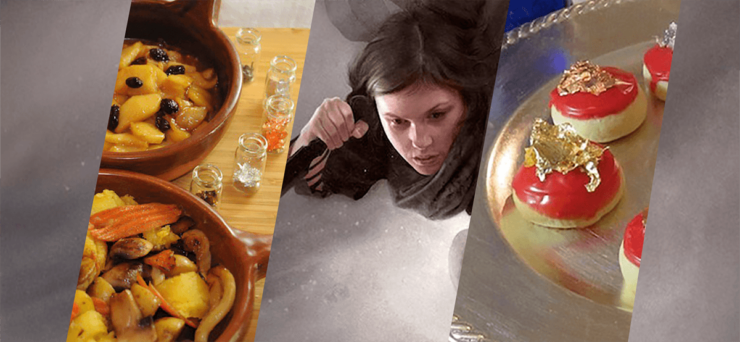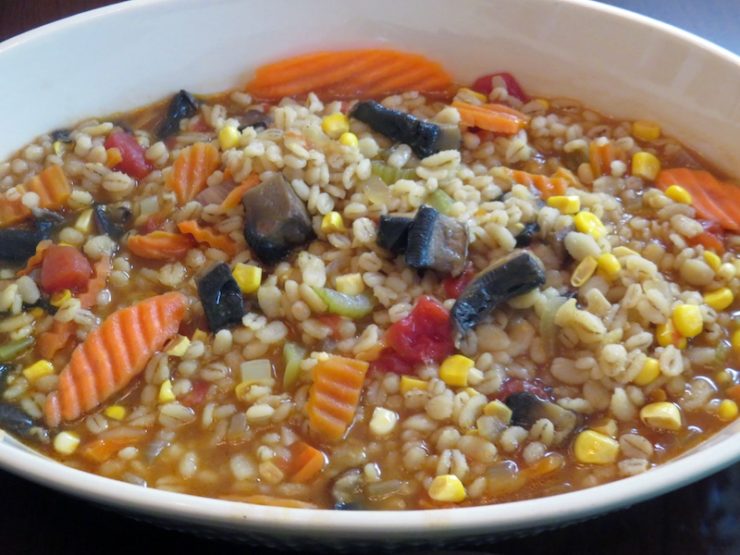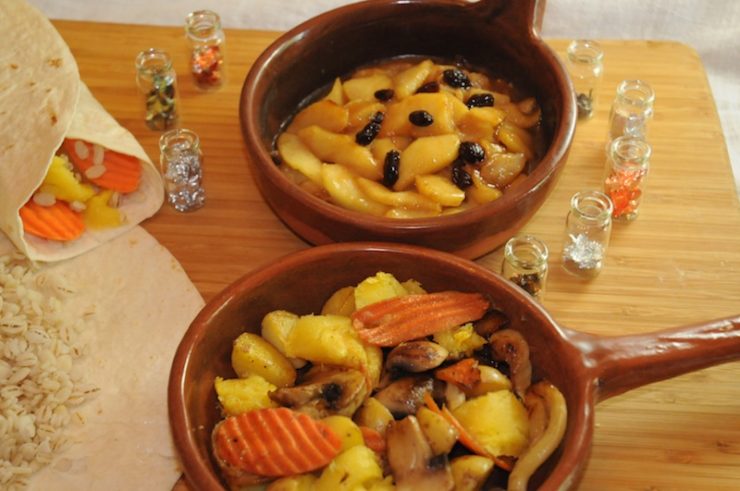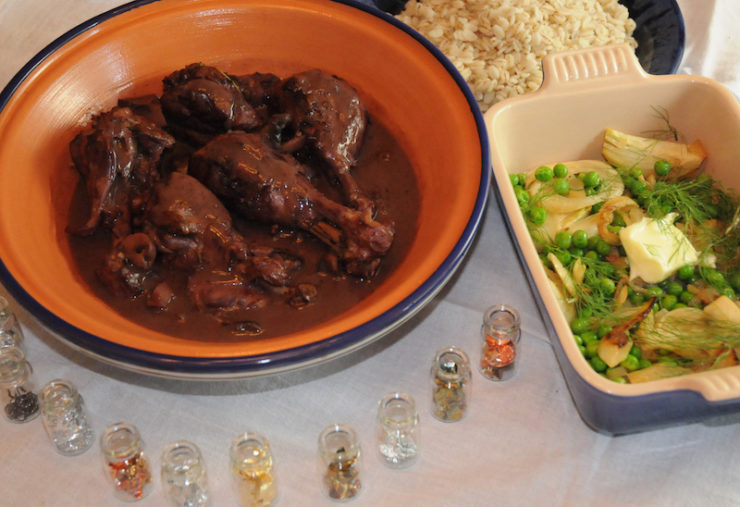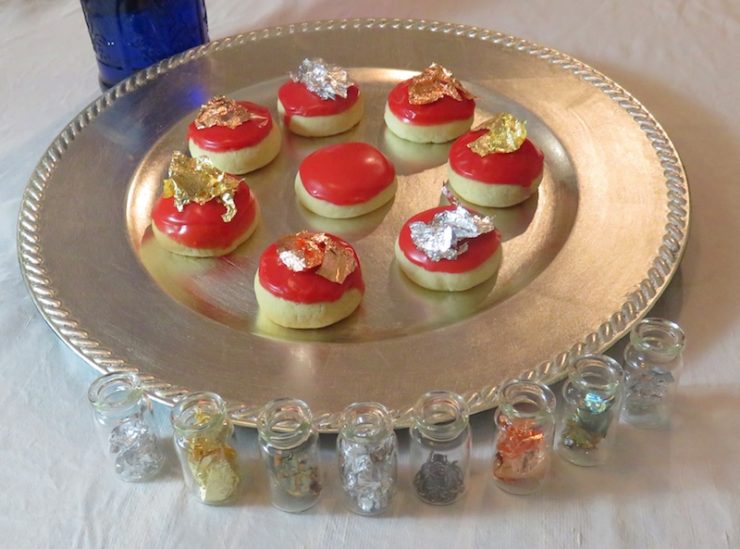Welcome Sanderson Fans, Cosmerenauts, and foodies to Tor.com’s newest adventures through the Cosmere! Here we ask the important questions about what the people on the worlds of Brandon Sanderson eat along with their ingested metals and investiture, starting with Scadrial during the Final Empire.
Have you ever asked what foods would best fuel an allomancer’s investiture? What foods would help a street kid like Vin obtain trace metals to generate her “luck”? What flavors would the nobles enjoy to compliment the tastes of their metals? In the same way people enjoy pairing meals and wines, how does one pair metals and meals?
Join Deana Whitney, a Sanderson Beta-reader and foodie, along with Michael Gunter, a cook skilled in many modern and historical food preparation methods, as they explore the different cuisines in the Cosmere food chain.
“Ash fell from the sky.”
It is a compelling first line. Soon we know that ashfall is like rain on Scadrial—simply part of the weather patterns. Then we learn that some people are able to eat metal to fuel magic—metal that would poison a regular human. This led to wondering how these two elements—weather/environment and Allomantic abilities—affect what people eat.
Before the Lord Ruler seized power, Scadrial was much like Earth, with the kinds of plants and spices we know in our world. During the Ascension, this all changed as Rashek first moved the planet about, then had to fix his mistakes. Given the atmospheric and biological changes, many green vegetables probably turned white or yellow during this time, yet we will say their flavors remained similar to Earth’s green versions.
In the Final Empire, plants mainly occur in shades of brown, red, yellow, and orange. The concept of green plants or delicate flowers is foreign to Vin. When thinking about the food of Scadrial, we run into the immediate problem that fruit comes from flowering plants. How do they have grapes, apples, and peaches, but no flowers? The answer, according to Team Dragonsteel, is that the Lord Ruler created plants with non-showy alternatives. Accepting that the fruit ripening cycle happens on Scadrial, we speculate that some fruits and vegetables survived their transformation to the ash world better than others. Root vegetables and foods with thicker skins are going to thrive in this environment. They would be easier to grow, and more likely to survive the ashfall without spoiling during the shipping process.
The Lord Ruler’s Scadrial is a world of hardship and scarcity, where food does not go to waste. Such cultures tend to develop dishes that use the whole animal. What parts the nobles do not want would go to the central kitchens to create meals and soup stocks for the skaa population. The cooks have trained the population to enjoy meals like blood sausage, liverwurst, tripe, and haggis. (Yes, we said haggis.)
Buy the Book


Mistborn: The Wax and Wayne Series
In developing these Scadrial menus, we pulled from history and from the clues we’re given in the books themselves. We tried to remain true to the world as it’s presented and described. Rather than offering many examples of specific meals or individual dishes, Sanderson uses mainly general food terms when he touches on the subject of eating: fruits, grains, and vegetables. Thus, we are not given a large base of foods we can use with 100% certainty. The existence of the Lord Ruler’s canneries indicates that preserved foods are going to dominate the cultural cuisine—even the foods being prepared in a nobleman’s kitchen. The mineral-rich waters of Luthadel, along with smoking, salt curing, and pickling, all work together to create a food profile different than our modern taste for all things fresh, one characterized by a tangy metallic flavor. For those with Allomantic abilities, the consumption of metals might enhance the sharp bite of a pickled vegetable or cured sausage. Mistings and Mistborn could enjoy their tin or bronze sprinkled over a dish of pork sausage, sauerkraut, and juniper berries.
For these menus, we focused on dishes described during the series. We tied the menus together using barley, the only grain mentioned by name in the books. Barley provides both nutrition and a feeling of fullness when eaten. Barley is a blank slate that can be flavored in a multitude of ways; this makes it the perfect vehicle for skaa and noble disbhes alike. Along with the other flavors, it would also absorb the trace metals from the cooking water, to help fill allomantic reservoirs.
Dining with the Skaa
Stews
Stews are mentioned multiple times in the series, and according to the books make up the majority of the skaa diet. Skaa from the farms have a hard life, but an easier time procuring a higher variety of crops for their stews. The city skaa make do with what the central kitchens provide, or—if they are of the artisan skaa class—might have their own kitchens. The rebel skaa army, while hiding in their caves, probably found a cavern or four suitable to growing mushrooms in order to help supplement their food supplies.
The skaa of the Final Empire would have access to different food, based on the location and environment of their Dominance. As Earthlings, by comparison, we have access to a much wider selection of produce and ingredients all year round. You can use any vegetables or whatever stock you enjoy while creating a version to match your choice of Dominance. For our version, we included a wide mix of textures and flavors.
Skaa Vegetable Barley Stew
Not just vegetarian, but also vegan, satisfying, and filled with umami. The aroma while the dish simmers will remind you of autumn comforts. This stew gives a warm, full-belly feeling on a cold night. The corn provides a sweet, crunchy contrast to the soft chew of the barley. Mushrooms absorb flavor and provide a meaty, chewy element. Tomatoes lend a hint of acid. The carrots and celery are tender, adding more texture and body to the stew.
Drink Pairing: A rich brown ale, like Newcastle Brown Ale
Ingredients
- 1 tablespoon olive oil
- 2 large carrots, chopped
- 3 cloves garlic, minced
- 1 onion, chopped
- 2 stalks celery, chopped
- ½ cup cooked corn niblets
- 1 (14.5 ounce) can diced tomatoes with juice
- 2 quarts vegetable stock*
- 2 portabella mushrooms, cut into ½″ dice
- 3 bay leaves
- 1 cup uncooked barley (we used pearl barley)
- 1 teaspoon salt
- 1/2 teaspoon ground black pepper
- ¼ teaspoon cumin
Directions
- Pour the olive oil into a heated large pot (8-quart). Add the onion, carrots, celery, and garlic. Cook until vegetables have softened, about 5 minutes.
- Pour your stock* into the pot. (*Stocks can be pre-made or made from scratch.)
- Add the rest of the ingredients and bring to a boil, cover and simmer over medium-low heat for 45 minutes, stirring frequently to prevent barley from scorching.
- If soup becomes too thick, add water or more stock. You may also adjust the amount of barley to your liking. After 35 minutes, start checking barley for tenderness. It may take longer, depending on your heat, so cook until the texture is correct. (The barley’s texture should be like rice, tender with a chewy mouthfeel. If it is mush, it’s been cooked too long.)
- Season with salt and pepper to taste.
Skaa Vegetable Stock
If you wish to go the extra skaa mile and create your own vegetable stock, we recommend this recipe.
Ingredients
- 1 onion, chopped
- 1 carrot, chopped
- 2 stalks celery, chopped
- 1 leek, including the rough green part, cleaned and chopped
- 1 potato, chopped into large chunks
- 1/3 cup mushrooms, chopped in half
- 3 cloves whole garlic
- 3 bay leaves
- 6 sprigs of parsley with stems
- 1 sprig of fresh thyme with stem
- 1 tablespoon soy sauce
- 8 cups of water
- ¼ cup whole peppercorns
- 1 tablespoon kosher salt
Directions
- Leave the skins on the onions and potatoes and leave the carrots unpeeled—just wash them, then chop them into large chunks.
- Place all ingredients into a large (8 to 12 quart) pot and bring to a boil. Reduce heat and simmer for at least an hour.
- Strain out the liquid. Use this as a base for soups, gravies, and more. This makes a rather dark and cloudy stock with a strong deep flavor. If you desire a lighter stock then leave out the potato and soy sauce.
Baywraps
Kelsier’s crew eat baywraps, often from Clubs’ kitchen. These are described as a barley and vegetable wrap, which sounds a bit like several different styles of food wraps in our own world. Since Vin takes an extra one to eat the wrap bread later, sans filling, this was a clue that the wrapping has substance on its own. Every culture develops some form of flatbread, and Michael and I decide the tortilla was the best analog, here: Tortillas have the right mix of sturdy to flexible called for with the baywraps.
At one point, Kelsier complains that Clubs’ cooks were not very imaginative with their filling ingredients. He has a valid point. While the basic description does sound boring, so does a taco, in theory. Yet there are hundreds of different taco fillings. The skaa of each region might have developed special local versions of baywraps, with one area only using beets and sweet potatoes, another using chickpeas and squash—or there may even be sweet versions of the wraps. The possible filling combinations multiply quickly. We challenge you to develop your own versions—yours could even include meat, perhaps as a treat for a special occasion. The wonderful thing about a baywap is that it can become whatever you want! Use the barley pilaf recipe below as the foundation for savory baywraps.
Drink Pairing:
Vegetable baywraps—German Amber lager or brown porter.
Sweet baywraps—Ale made from same fruit as your filling.
Savory Barley Pilaf
Ingredients
- 1 tablespoon of oil
- 1 small onion, finely chopped
- 3 cloves of garlic, finely chopped
- 1 cup pearl barley
- 2 cups stock
- 1 teaspoon salt
Directions
- In a heavy saucepan place oil, onion, and garlic. Using a medium heat, cook until softened.
- Add the dry barley and cook, stirring, until the barley gets slightly toasted.
- Add the stock and salt to the pan, and bring stock to a boil.
- Turn down heat to a simmer, cover and let simmer for 45 minutes. Check several times to avoid sticking.
- If there is extra water or stock left over, strain the barley, and set it aside.
Savory Baywrap
To create a savory baywrap, take a tortilla, warm one side in a pan with butter. Then add a spoonful of the savory barley pilaf, add vegetable filling of your personal choice, wrap it up and enjoy!
If you wish, you can add the vegetables to your stock while the barley simmers, or cook separately to create different types of baywraps using the same pilaf.
Sweet Baywrap
For a sweet application, think of a Scottish Barley pudding. Cook some apples and pears in a different pan with butter and spices, then add them to the wrap after the barley pudding is ready. Warm one side of the tortilla in a pan with butter and sugar before filling the wrap.
Pictured fillings: The lower is carrot, potato, roasted acorn squash, garlic, and onion sautéed in olive oil. Upper filling is apples, pears, and raisins cooked in butter, sugar, and cinnamon.
Dining with the Nobles
Drumsticks, Butter Vegetables, and Cakes
The nobles of Scadrial obviously have access to a wider variety of foods than the skaa. The first notable difference in a noble’s diet is consistent access to meat. It is unclear how often artisan-class skaa eat beef, pork, and chicken, or even the insides of an animal, like tripe. What is clear is that the nobles do enjoy meat regularly in a variety of ways. Lord Straff Venture enjoyed a beef steak, for example, while hosting Elend and Vin for dinner (even though he didn’t enjoy the rest of their visit).
The noble houses, due to the tradition of hosting opulent balls, have a tradition of serving food more in a buffet style, rather than presenting individually plated food. Sazed serves Lady Valette food from larger chafing dishes at the balls; while he arranges it artistically, buffet style is the default cuisine service style. Thus, if metals were to be served along with a dish, they would likely be served in shakers like salt and pepper. Mistings could simply choose the metal that matches their power.
Lord Cett, in particular, seemed to enjoy his food. He also used it as a weapon to make Elend feel uncomfortable by serving a drumstick dish with a rich sauce. (Just looking at the red gravy Michael created for this recipe made me worry for all white cloth at dinner!) The meal was a treat of falling-off-the-bone tender chicken. The tangy acids in the red wine were mellowed by the butter in the reduction sauce, creating a savory taste with just enough spice to awaken taste buds. The sauce was prone to drip and splatter if I was not very careful while eating the meat, while the savory barley both absorbed the rich sauce and provided a decorative platform to serve the meal upon.
Drink Pairing: The red wine used in the sauce. If Breeze is attending the dinner, buy three extra bottles.
Drumsticks in wine sauce
Ingredients
- 8 bone-in chicken legs
- 8 ounces bacon, sliced crosswise into 1/2-inch pieces
- 10 large button mushrooms, quartered
- 1/2 large yellow onion, medium diced
- 2 garlic cloves, sliced
- 2 teaspoons all-purpose flour
- 2 teaspoons butter
- 6 1/2 cups red wine (We used Coppola Red Blend, which includes Cabernet Sauvignon grapes)
- 1 cup chicken broth
- 6 sprigs fresh thyme
Directions
- Preheat oven to 375 degrees F.
- Remove the skin and season chicken legs all over with salt and black pepper.
- Use an oven-proof skillet or Dutch oven. Place bacon in the dish, cook it over medium-high heat, turning occasionally, until evenly browned, about 10 minutes. Transfer bacon with a slotted spoon to a paper-towel lined plate, leaving drippings in the skillet.
- Increase heat to high and place chicken into skillet. Cook until browned, 2 to 4 minutes per side. Transfer chicken to a plate; drain and discard all but 1 tablespoon of drippings from the skillet.
- Lower heat to medium; sauté mushrooms, onion, and garlic until golden and caramelized, 10 to 15 minutes.
- Add butter and let melt, stirring into mixture.
- Sprinkle flour over vegetables and stir until vegetables are coated and flour begins to brown.
- Pour red wine into the skillet and bring to a boil while scraping browned bits of food off of the bottom of the pan. Stir bacon and thyme into red wine mixture; simmer until wine is about 1/3 reduced, 3 to 5 minutes. Pour chicken broth into wine mixture and set chicken into skillet; bring to a simmer.
- Place pot into oven for 45 minutes. Uncover and check for doneness: Chicken should read around 165 F on an instant read thermometer and be easily pierced with a fork with no red juices coming out.
- Once done, remove chicken to a serving platter.
- Place cooking pan on stove and turn flame on high. Reduce pan juices until sauce thickens slightly, about 5 minutes. Season with salt and pepper; remove and discard thyme. Pour sauce over chicken.
- Note: if you want the sauce to be thicker, mix 1 tablespoon of corn starch into 2 tablespoons of water. Stir into a paste. Add half of the paste to the sauce. Cook for a minute—if it is still too thin, add the rest of the paste and cook for another minute.
- Serve dish with savory barley pilaf topped with edible gold and silver.
Butter Vegetables
For the butter vegetables, Michael went out on a limb by including green peas and fennel greens. Lord Cett is from a different Dominance than Vin—green peas and fennel might be found there as a rarity. Nobles enjoy showing their wealth through their food choices: including something like a green vegetable would certainly do that on this world of few green plants. (On Earth, we could be exotic by using yellow peas, but we did not find any while prepping for this meal.)
The fennel in this dish brings out the tangy mineral notes enjoyed on Scadrial, while the peas, squash, and onions counter it with sweet notes, along with multiple textures. These vegetables can be served on their own, or over the barley pilaf along with the chicken.
Ingredients:
- 1 full fennel bulb
- ½ onion, medium dice
- 3 garlic cloves, sliced
- ¼ lb butter (1 stick)
- 2 teaspoons olive oil
- 1 cup vegetable stock
- ½ cup white wine
- A few sprigs of thyme
- 1 acorn or butternut squash, cubed or scooped, cooked*
- 3 cups frozen green peas, defrosted
- Salt and pepper to taste
- 1 teaspoon butter as garnish
*Cook the acorn or butternut squash before cooking the rest of the dish.
Directions
- Cut squash in half lengthwise.
- Oven Baked Squash: Preheat oven to 400 degrees F. Place squash halves on a large baking sheet flesh side up. Place 1 teaspoon butter in the middle of each squash and roast 50 minutes or until tender.
Microwave Baked Squash: Rub squash with butter or oil and cover with cling film. Cut a slit in the film to let steam escape. Cook for about 15 minutes for butternut and 10 minutes for acorn.
Cooking the main dish:
- To trim the fennel, cut the top stalks from the bulb and reserve several of the fronds for garnish. With a vegetable peeler, peel off the top layer of tough skin from the bulb. Once trimmed, place bulb flat on a cutting board and slice down into thin slices. Take slices flat on the board and cut into thin sticks.
- In a heavy saucepan, heat oil until shimmering. Add fennel, onion, garlic, and butter. Cook until vegetables soften, about 5 minutes.
- Add vegetable stock, wine, and thyme sprigs. Bring to a boil and then simmer about 15 minutes.
- Add peas and cook until they are cooked through and tender.
- Add cooked squash and simmer for another minute until heated through.
- Season with salt and pepper.
- Remove vegetables from the cooking broth and transfer to a serving plate. Pour a little of the liquid over them, and top with a teaspoon of butter and a sprinkle of the fennel fronds.
Small Cakes
A sweet treat is the proper way to end a noble’s meal. But not a chocolate treat—we have to wait until Era 2 for chocolate. The Ministry served small cakes in their waiting room. Kelsier enjoyed multiple small red iced cakes while he observed Vin and Camon. He even stacked four of them in his hand at once.
The definition of a cake is flexible, and has changed over time, depending on history and location (much like a “biscuit” currently means a sweet cookie in the U.K. but refers to a bread item the U.S.A.). Inspired by the Renaissance, we thought a fluffy cookie could serve as a cake analog. This recipe is based upon iced Italian cookies—these are a cross between shortbread and sugar cookies. The interiors are fluffy, with a satisfying crunch to the exterior. These will seem not very sweet to modern palates, and have the light taste of vanilla. The metal looks wonderful shining against the gloss of the icing.
Drink Pairing: Moscato wine
Ingredients (Icing)
- 1 ¾ cups powdered sugar (½ of a 1-pound box)
- 2 – 4 tablespoons milk
- 1 tablespoon vanilla or extract of choice
- Food coloring of choice—for red colors use powdered food coloring.
Directions
- Whisk powdered sugar, extract, and food coloring together.
- Add milk slowly, one tablespoon at a time, to form a soft, smooth icing. Whisk to incorporate the milk. Look for the flow of warm syrup. Set aside in a bowl.
Ingredients (Cookie)
- 1/2 lb butter, softened (2 sticks)
- 2 large eggs, beaten
- 1 cup sugar
- 4 cups flour
- 2 tablespoons baking powder
- 1 1/2 tablespoon vanilla, more if desired
- Recipe will make 30 to 40 cookies.
Directions
- Cream room temperature butter and sugar together, until soft and well blended.
- Add eggs and vanilla, mixing well.
- Combine flour and baking powder in a separate bowl, and then blend into the butter mixture, one cup at a time. Dough will form large clump.
- Break off small, prune-sized pieces of dough and roll into disks about 1/2” thick.
- Bake in a preheated oven at 350 degrees F until lightly browned, about 18-22 minutes.
- Cool on wire racks for two minutes.
- While cookies are still warm, dip the top into the premade icing, as desired. Icing should flow around the cookie, but not drip off in excess.
- Place on wire rack, with wax paper underneath to catch any icing drips. Re-dip in the icing for a thicker coverage.
- Let finish cooling. Decorate with metal flakes as desired.
We hope you enjoyed this food journey into Cosmere cuisine. Which foods do you want to try from our menus? Are you more excited by the skaa or the noble menu? Share your thoughts with us in the comments…
Photos: Taken by Deana Whitney
Originally published June 2018
Deana Whitney is a Sanderson beta reader, a historian, and loves to make book-inspired cakes for her birthdays. She is known around Tor as Braid_Tug and was overjoyed when this article allowed her love of food and the Cosmere to combine.
Michael Gunter is a historical cook and researcher who has written several papers on historical dining and been the featured speaker at historical culinary symposiums. He has served historical dinners to parties ranging from 30 to 400.










